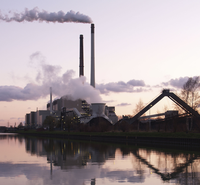
Photo from wikipedia
Abstract Rapid economic growth and associated emission increase in China have led to severe air pollution in recent decades. As fine particulate matter concentration is decreasing due to strict control… Click to show full abstract
Abstract Rapid economic growth and associated emission increase in China have led to severe air pollution in recent decades. As fine particulate matter concentration is decreasing due to strict control measures, ozone (O3) concentration has an increasing trend with adverse effects on human health and ecosystems. In this study, the Community Multi-scale Air Quality (CMAQ) model was used to investigate the formation of O3 in China during three high concentration episodes in summer 2013 and analyzed its sensitivity to emission changes. Compared with observation data, O3 performance met the EPA criteria of mean normalized bias (MNB) within ±0.15 in major parts of China including five megacities. The diurnal variation of O3 had similar trend with temperature. The August episode (6–12) had the highest daily maximum 1-h O3 of ∼100 ppb in North China Plain (NCP), while the July episode (11–19) had the lowest concentrations of ∼50 ppb. The O3 production rates (OPR) were higher at NCP and the Yangzi River Delta (YRD), but O3 production efficiencies (OPE) acted in contrary. O3 isopleth showed that NOx controlled O3 concentration in most areas of China. Reducing VOC would have minor effects on O3 concentrations while reducing NOx could largely reduce O3 concentration except for urban areas such as Shanghai and Guangzhou. Linear correlations were observed between secondary organic aerosol (SOA) and Ox (O3+NO2) concentrations in August at Shanghai and Guangzhou, indicating correlations between O3 and other photochemical compounds. This study provides valuable information for designing effective control strategies for O3 in China.
Journal Title: Atmospheric Pollution Research
Year Published: 2019
Link to full text (if available)
Share on Social Media: Sign Up to like & get
recommendations!